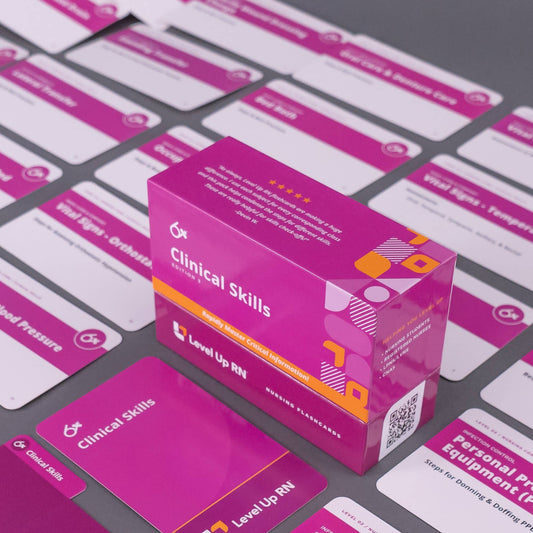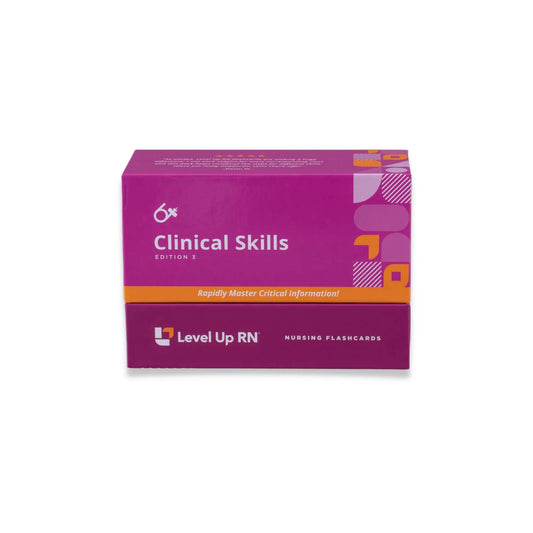Clinical Skills - Emptying and Changing an Ostomy
Updated: Ellis ParkerHow to empty and change an ostomy device and how to prevent pain and discomfort for the patient during this process.
Full Transcript: Clinical Skills - Emptying and Changing an Ostomy
Full Transcript: Clinical Skills - Emptying and Changing an Ostomy
Hi, I'm Ellis with Level Up RN. In this video, I'll be demonstrating both how to empty an ostomy as well as change an ostomy wafer. I'll be following along with the steps in our clinical nursing skills deck. So if you have this deck, grab the corresponding cards and you can follow along with me. If you don't have the deck and you're interested in checking it out, head on over to leveluprn.com.
After the demonstration, don't forget to hang out for just a second because I'm going to be providing just one more tip for you. In preparation for changing my patient's ostomy bag, I've gone ahead and gotten a new ostomy set, a washcloth, a measuring guide, some scissors, a marker, and some skin prep. You will always need to measure a patient's ostomy. As they've had it for some time and their ostomy settles, it is usually the same size. But especially when a patient's ostomy is new, it is liable to change sizes with inflammation and settling and things like that. So we're always going to be working with our measurement tools.
So the first step, of course, is to remove the old ostomy. So regardless of the type of system, whether it's a two-piece or a one-piece, the wafer is adhered to the skin. So I'm going to want to move my bag and I'm going to want to push down on the skin and gently lift the wafer. Right? I'm not going to rip it off like a band-aid because I don't want to cause any skin tears or any issues with their skin irritation or anything. So I want to remove this as gently as possible. So I'm going to push down on the skin and remove that wafer, discarding it. I can now assess my ostomy, making sure that it's beefy red and that it doesn't have any signs of ischemia or skin breakdown in the periostomy area. I'm going to get a damp, warm washcloth with no soap and just clean around the external part of the ostomy and then making sure that that dries completely before I place the new system on.
The system I'm using is a two piece today, so I'm going to go ahead and separate it so I can work with my wafer because I'll be needing to cut the ostomy size. So I take my measuring tool, and I'm going to place it over the ostomy itself so that I know what size to cut my wafer. Now, I want my wafer to fit snugly against the ostomy so that no leakage occurs and the peristomal area doesn't get breakdown, but I don't want it to fit so snugly that it constricts the ostomy and it prevents things like blood flow from happening. So I'm going to try a couple of different options. That one looks a bit too large. That one's a little too small. I feel like Goldilocks, but that's just right. So you can see that it fits snugly. It's about one-eighth of an inch around the ostomy stoma itself. So I'm going to use this as a guide to select the size on my ostomy wafer. There are lines that indicate it, but I'll go ahead and mark it just for my own comfort making sure that I cut the right size out. I'm going to get some blunt-tipped scissors, and I'm going to cut that circle out. If my patient is capable of helping with these tasks, it's always important to get them involved so that they can do this when they go home. We want to make sure that they or their caregiver or loved one is able to provide them these services after they leave the facility.
So I'm trying to do this as smooth as possible which is hard because I'm also trying to do it fairly quickly. But I've got my appropriately sized ostomy hole. I'm then going to remove the backing of it. I can get a piece-- I can get a pack of preparatory, something that prepares the skin for adhesive. It helps prevent breakdown, and it helps when we're ready to remove the skin-- excuse me, remove the wafer that it prevents any damage from the skin, so it prevents that skin breakdown. So I'm going to remove all of the adhesive protectants on my wafer and place it around my stoma, pressing it so that it is firmly against the skin again so that none of the effluents that's exiting the stoma can get under the wafer and come into contact with the skin itself. I can press it down for a few minutes, making sure it is firmly set in. And then because I've got the two system-- or the two-piece system, I just need to snap my top piece into my bottom piece or my bag onto my wafer so that the bag is securely attached to catch the effluent from the stoma. And that's how I changed my ostomy appliance.
Emptying an ostomy bag for a patient is going to need to be done before it reaches one-half full, so we want to maybe do it a third to a half full. Because the more effluent or waste that is in the bag, the heavier the bag gets and the more likely it is to either detach from the wafer, from a patient, or even just come open. And we don't want any of that effluent or waste draining anywhere and causing an issue. So to prepare to empty the bag, I'm just going to remove the clip. This particular one has a snap clip. It should be noted that there are a lot of different types of ostomy bags. Some are velcro. Some you don't empty and you just change the whole bag. But this one has a clip. And I'm going to actually roll the end of this bag down a little because when I allow the waste to exit, I don't want it to touch the outside of the bag and potentially get on anything else. So I'm just going to make a little cuff there, and I'm going to allow it to drain into a graduated cylinder. And you may need to encourage it to exit.
I could also use a bedpan for this, or if my patient were ambulatory, they can do this over the toilet or commode. So I'm going to just empty it out as much as I can. And I'll say, that's sufficient just for this video's purpose. I'm going to use a washcloth, but a piece of paper towel or toilet paper is even okay. I'm just going to wipe the edges and make sure that I don't get any on the external part of the bag to reduce the potential for contamination and the potential for smell. I'm going to then uncuff the bag, and I can see that that bottom piece is free of stool. And I'm going to recuff the bag so that no leakage occurs. And I've emptied my ostomy.
During that demonstration, I showed you how to measure, cut, and apply the wafer and then how to apply the bag onto a wafer for the two-part systems. However, when I showed you how to apply the bag, I matched my rings up and I pushed down because that's how it's always been demonstrated to me. When I showed the team this video, one of our nurses, Maris, had some amazing insight that I wanted to share with you. She actually has had an ostomy before so she can share personal experiences about what that's like. And she told me that when someone puts the bag onto the wafer like this, it is extremely painful. At best, it's uncomfortable. But especially if the ostomy is new, it's very, very painful. And she pointed out that there's a lip under this plastic piece for you to hold so that when you're pushing down on the ring, you're not actually pushing down on the patient, but you're applying that counter pressure for it. So I'll align my rings, and then I simply pinch around the ring. And at no point do I have to apply pressure onto the patient's abdomen, and that can really make your patient much more comfortable and prevent a lot of pain and discomfort.


